Bu makalede, NGINX, MariaDB ve PHP 8.2 kullanarak bir Ubuntu 22.04 sunucusuna WordPress’i manuel olarak kurma sürecini öğreneceksiniz. Bu yığın, WordPress web sitenizi inanılmaz bir hızla çalıştırmak için güçlü ve verimli bir platform sağlayacaktır.
Bu 3 adımı izleyin ve videoyu izleyin. Yardıma ihtiyacınız var? benimle iletişime geçin. 😊
Şimdi başlamadan önce, işte size kısa bir ipucu. Kullanım Search and Replace Extension yığın içinchange
Google Chrome kullanıcıları için zaman kazandıran ipucu.example.combu web sayfasındaki kendi alanınıza.
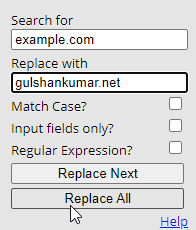
Parça A: Sakla Cloudflare Nameservers aktif
Biz kullanacağız Cloudflare DNS almak için Let’s Encrypt Wildcard SSL certificate. Sıfır kesinti süreli geçişin keyfini çıkarmak için önce bu adımı tamamlayın.
Kontrol et Current Nameservers
- Etkinliğinizi bulun Nameservers at https://www.whatsmydns.net/#NS/example.com
- Önceki kullanımınızı görüyorsanız Hosting or Domain registrar default NS, o zaman Cloudflare ile değiştirmelisiniz.
- Öğrenmek nasıl kullanılır Cloudflare DNS
Parça B: Get a Ubuntu Server 22.04 LTS Server ready

1. Kaydolun Vultr to 100 $ Ücretsiz kredi kazanın (30 gün boyunca geçerlidir)
Pek çok Bulut sunucu şirketini denemiş biri olarak, deneyimlerim Vultr ile yanlış gidemeyeceğinizi söylüyor. Bu adamlar destek ve hizmetler söz konusu olduğunda samimi ve ilgili.

⚡ Performans
- NVME / SSD
- 3.7 GHz CPU
- Up to 5Gbps Network Speed
- Datacenter in America, Europe, Asia, Austraillia
- IPV6 ready
💡 Özellikler
- Beginner-Friendly Dashboard
- One-click to Snapshot
- Automtatic Backup (Paid)
- Free Cloud Firewall
- DDoS protection (Paid)
- 100% KVM Virtualization
⚙ Destek
- PayPal/Card
- 24/7 Ticket Support
- Documentation
2. Yeni bir VPS Server
Başlamak için artı düğmesine tıklamanız yeterlidir
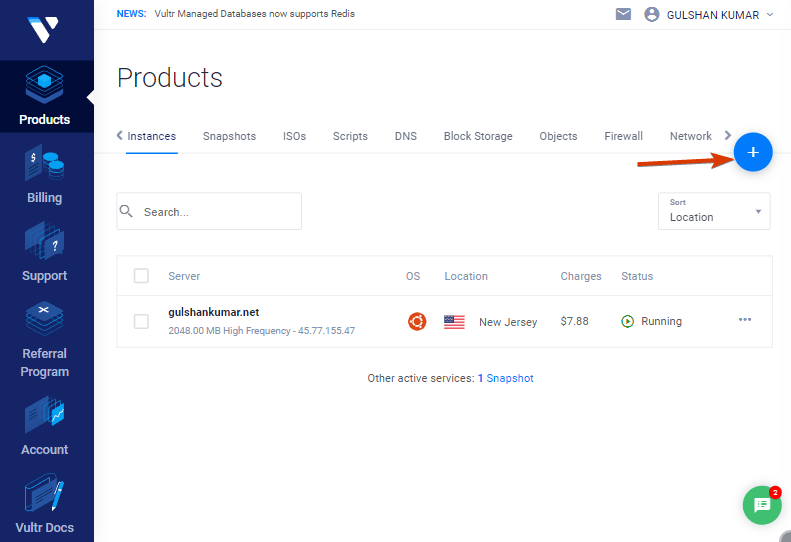
3. Seçin Server type

Ardından, şunları seçmeniz gerekir CPU & Storage Technology, tercih edebilirsiniz “AMD High Performance”.

4. Bir seçim yapın Server Location
Hedef kitlenize yakın bir sunucu konumu seçin.
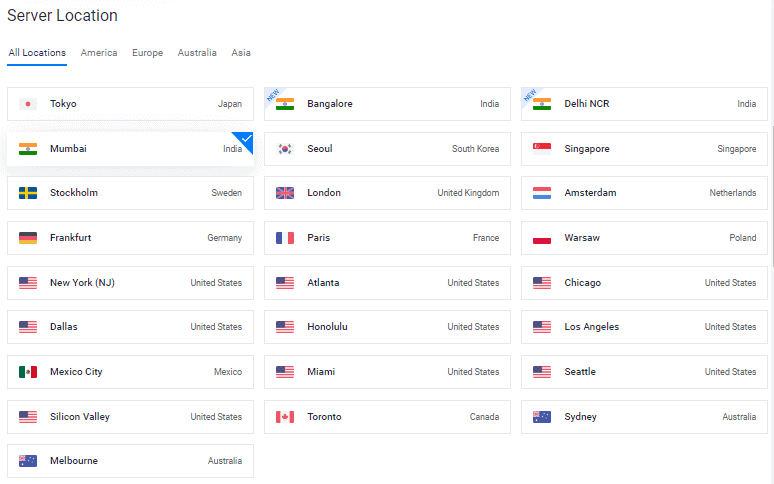
5. Seçiniz Ubuntu 22.04 x64 OS
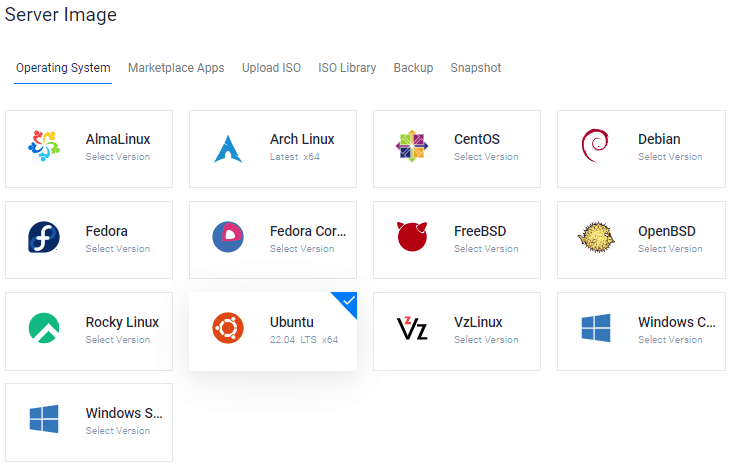
Uzun vadeli destek (LTS), bilgisayar yazılımının kararlı bir sürümünün standart sürümden daha uzun bir süre boyunca muhafaza edildiği bir ürün yaşam döngüsü yönetim politikasıdır.
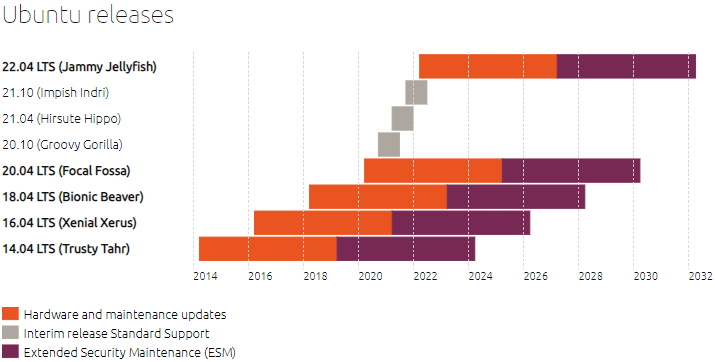
6. Bir seçim yapın Server Size
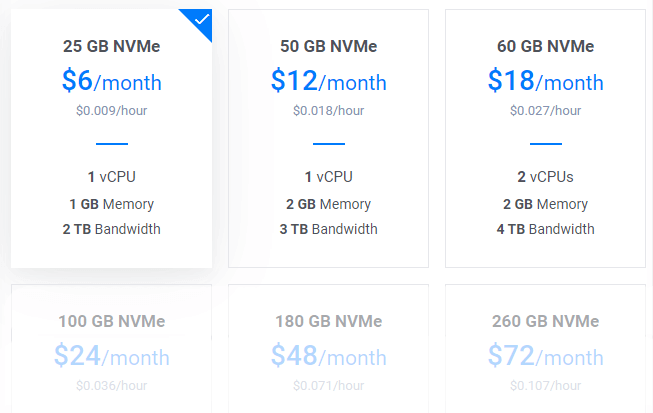
6 $ / ay planı yeni bir blog için harika bir başlangıç noktası olacaktır. İhtiyaca göre istediğiniz zaman yükseltebilirsiniz.
İpucu: Eğer geçiş yapıyorsanız, Toplam kurulum boyutu Site health info.
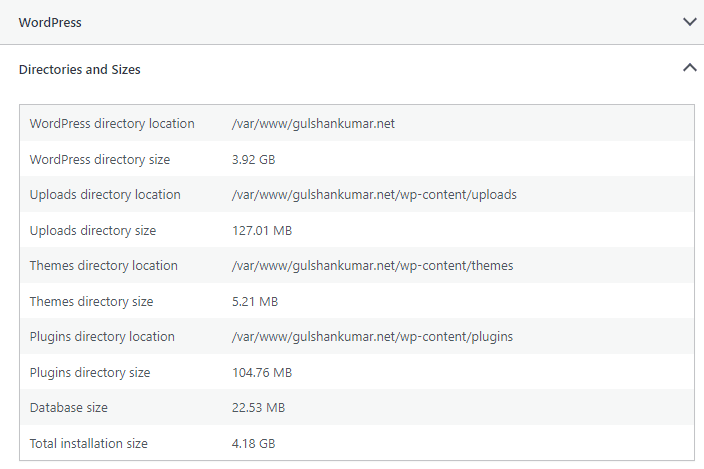
7. Etkinleştir IPV6, Backup
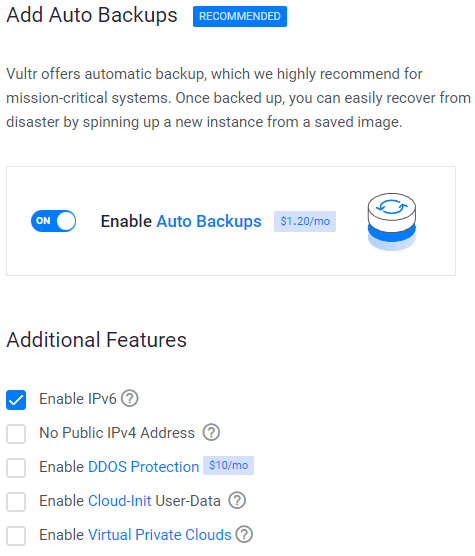
8. Ekle SSH key
Bu, aşağıdakiler için önerilen, isteğe bağlı bir adımdır geli̇şti̇ri̇lmi̇ş güvenli̇k.
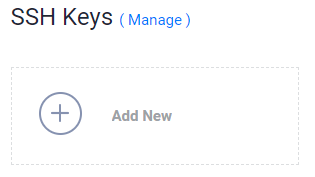
- Tıklayınız Add New düğmesi ile yeni bir SSH key göndermek için 🔒Public key.
- İşletim sisteminize göre aşağıdaki yöntemi kullanarak Anahtarları Oluşturun.

- İndir PuTTy application.
- Aramak için PuTTygen in the Start menu
- Tıklayınız Generate button and hover mouse pointer
- Copy Public key and provide to Vultr
- Enter key passphrase
- Save 🔑Private Key at the safest location.
- Bu, SSH veya SFTP’ye giriş için kullanılabilir.

- Run:
ssh-keygen -t rsa. For a more secure 4096-bit key, run:ssh-keygen -t rsa -b 4096 - Anahtarı nereye kaydetmek istediğiniz sorulduğunda enter tuşuna basın (bu varsayılan konumu kullanacaktır).
- Enter a passphrase for your key.
- Run
cat ~/.ssh/id_rsa.pub– this will give you the key in the proper format to paste into the control panel. - Yedeklediğinizden emin olun
~/.ssh/id_rsafile. Kaybolması halinde geri getirilemez.
Seçiminizi yapın SSH key
Bu adımları izleyerek açık anahtarınızı yeni Örneğinize ekleyebilirsiniz. Ardından, hem Düz Metin parolasını hem de SSH anahtarını kullanarak SSH’ye giriş yapabileceksiniz.

9. Link Web Firewall rule to Server Instance

- Yönet’e tıklayın ve yeni bir Firewall Group.
- Allow TCP port 22 for SSH. 80 for HTTP and 443 HTTPS for IPV4 and IPV6 rules both.
- Bunu yaptıktan sonra Firewall group to your Instance.
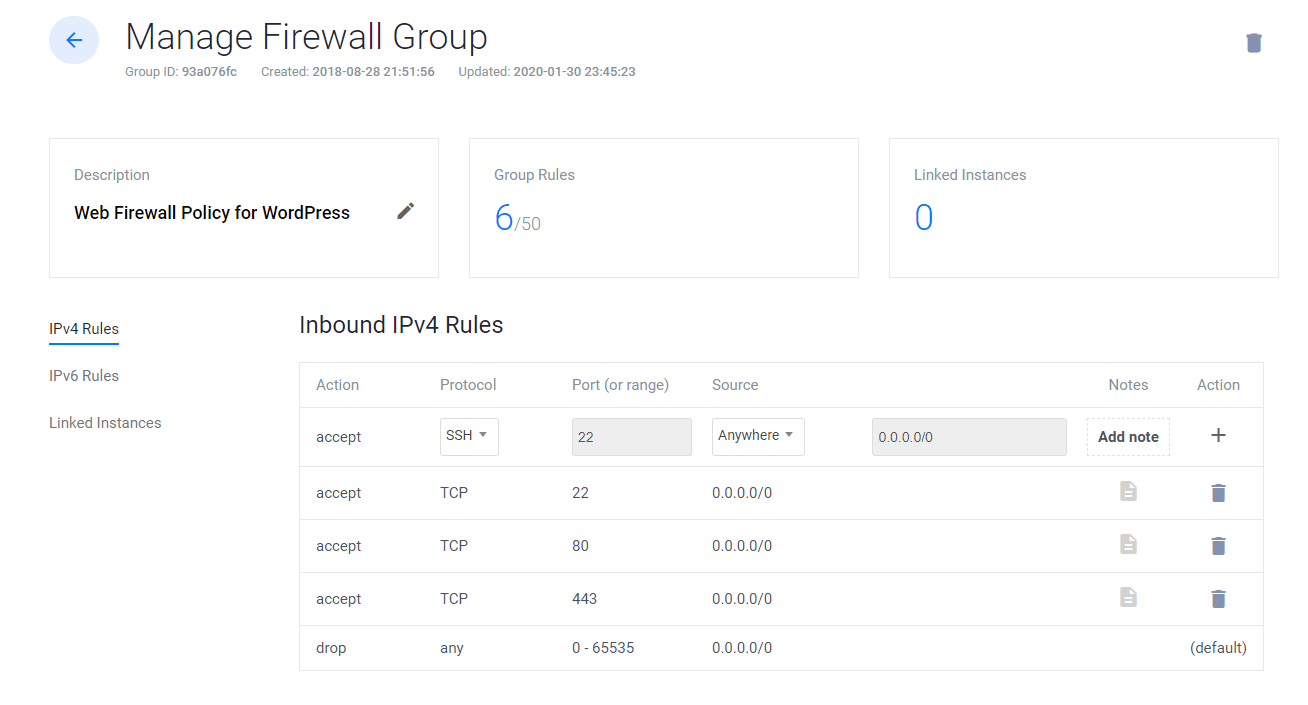
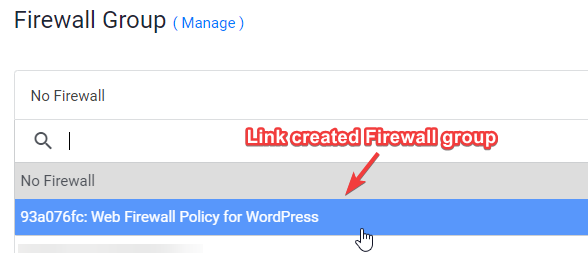
10. Enter Hostname and label tıklayın Deploy Now
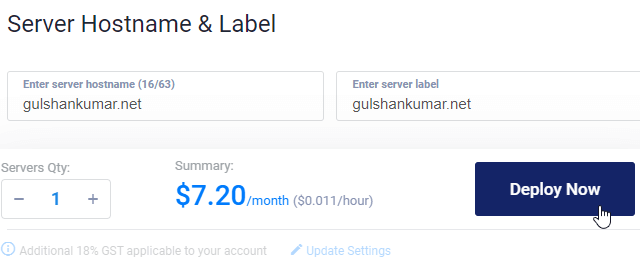
Şimdi, ilerleme bölümünde yükleme işlemini göreceksiniz
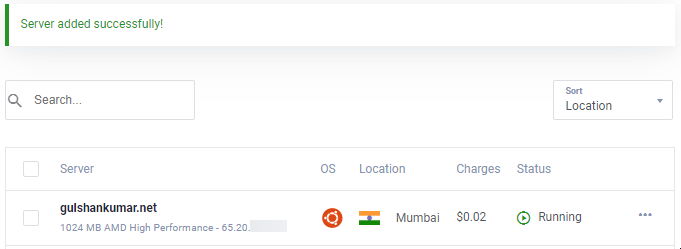
11. Yeni’ye git Instance page
Copy IP address, username and password. Senin default port is 22.
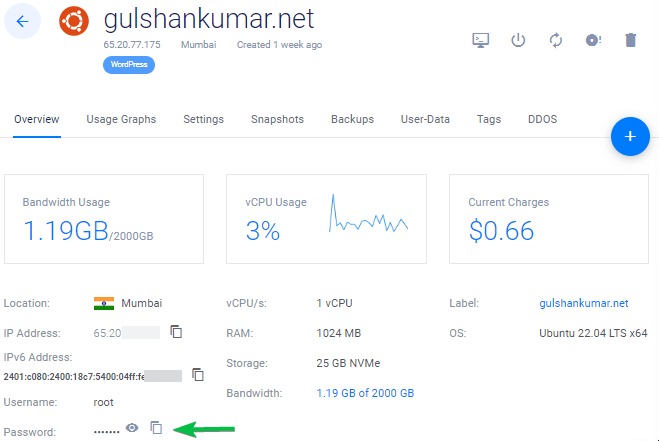
12. Devre dışı bırak Password Login
Güvenlik nedeniyle, parola kimlik doğrulamasının devre dışı bırakılması ve yalnızca anahtar tabanlı kimlik doğrulamasına izin verilmesi önerilir.
- Edit the configuration file
nano /etc/ssh/sshd_config - Find (CTRL + W) and search
PasswordAuthentication - Change value from yes to no
- To save type, CTRL + O
- Restart the SSH service using command
sudo service ssh restart
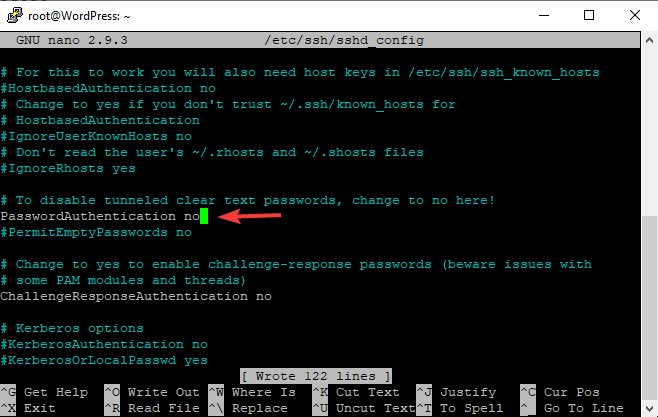
Bir sonraki seferden itibaren, SSH’yi yalnızca videoda gösterildiği gibi anahtar aracılığıyla kullanabilirsiniz.
İçin Linux or Mac, use Terminal with command like this
ssh root@192.168.1.1 -p 22 -i id_rsa
Adım 13. Devre dışı bırak UFW
VULTR’de yeni bir örnek dağıttığınızda, SSH bağlantı noktası 22 hariç tüm bağlantı noktalarını engelleyen UFW (Karmaşık Olmayan Güvenlik Duvarı) etkinleştirilmiş olarak gelir. Bu geri dönebilir ERR_CONNECTION_REFUSED Error in the browser. Bunu düzeltmek için şunları tutmanızı öneririm UFW disabled.
ufw disableTemel şeyler için bu kadar açıklama yeterli. Şimdi, WordPress’i LEMP yığını üzerinde dağıtmak için orijinal süreci hızlandıracağım.
Parça C. Deploy WordPress üzerinde LEMP Stack
1. Update repositories
Aşağıdaki komutu yazın ve enter tuşuna basın
sudo -sapt update && apt upgrade -y && apt dist-upgrade && apt autoclean && apt autoremove -y && rebootveya
wget -qO update https://dl.gulshankumar.net/update && chmod +x updateBir dahaki sefere, güncellemek için her zaman aşağıdaki kısayol komutunu kullanın.
./update2. Kurulum MariaDB güvenlik ile
Tekrar giriş yapın ve aşağıdaki komutu girin
sudo apt install mariadb-server -y && sudo mysql_secure_installationAşağıdaki soruları cevaplayın
- Enter current password for root (enter for none): Enter tuşuna basın
- Switch to unix_socket authentication [Y/n]: n yazın ve Enter tuşuna basın.
- Set root password? [Y/n]: Enter tuşuna basın.
- New password: Dashlane Password Generator’dan güçlü bir parola kopyalayın. SSH konsoluna bir parola yapıştırmak için sağ tıklayın ve Enter tuşuna basın. Parola ekranda görünmeyecektir.
- Re-enter new password: Sağ tıklayın ve Enter tuşuna tekrar basın.
Başarılı şifre ayarından sonra, şunları göreceksiniz
Password updated successfully! Reloading privilege tables.. ... Success!
Ayrıca, aşağıdaki soruları da yanıtlamanız gerekmektedir.
- Remove anonymous users? [Y/n]: Y tuşuna basın ve girin
- Disallow root login remotely? [Y/n]: Y tuşuna basın ve girin
- Remove test database and access to it? [Y/n]: Y tuşuna basın ve girin
- Reload privilege tables now? [Y/n]: Y tuşuna basın ve girin
3. Yeni bir Database için WordPress
Giriş yapmak için MySQL, press enter key şifre sorduğunda.
mysql -u root -pYeni bir Database, and Grant Privileges ile kullanıcısını kullanmak için password. İşte burası WordPress store all post, pages, themes, plugin, etc information.
create database wordpress;
grant all on wordpress.* to gulshan@localhost identified by '5pY8CKJxDRJEGQNkX7';
flush privileges;
exit;Where your …
database is wordpress
username is gulshan
password is 5pY8CKJxDRJEGQNkX7
İpucu: Benzersiz oturum açma kimlik bilgilerini kullanmayı düşünün
4. Install PHP 8.2, NGINX and set Permission
sudo add-apt-repository ppa:ondrej/php -y && apt update && apt install php8.2-fpm php8.2-common php8.2-mysql php8.2-xml php8.2-xmlrpc php8.2-curl php8.2-gd php8.2-imagick php8.2-cli php8.2-dev php8.2-imap php8.2-mbstring php8.2-soap php8.2-zip php8.2-bcmath -y && sed -i 's/;cgi.fix_pathinfo=1/cgi.fix_pathinfo=0/g' /etc/php/8.2/fpm/php.ini && service php8.2-fpm restart && apt install nginx -y && chown -R www-data:www-data /var/www/ && chmod -R 755 /var/wwwTweak PHP Configuration
Çoğu fancy theme and plugin requires high-end PHP configuration to run. Bu nedenle, bu değişiklikleri yapmalıyız.
sed -i 's/memory_limit = 128M/memory_limit = 512M/g' /etc/php/8.2/fpm/php.ini
sed -i 's/post_max_size = 8M/post_max_size = 128M/g' /etc/php/8.2/fpm/php.ini
sed -i 's/max_file_uploads = 20/max_file_uploads = 30/g' /etc/php/8.2/fpm/php.ini
sed -i 's/max_execution_time = 30/max_execution_time = 900/g' /etc/php/8.2/fpm/php.ini
sed -i 's/max_input_time = 60/max_input_time = 3000/g' /etc/php/8.2/fpm/php.ini
sed -i 's/upload_max_filesize = 2M/upload_max_filesize = 128M/g' /etc/php/8.2/fpm/php.ini
service php8.2-fpm restart5. Kurulum Wildcard Let’s Encrypt SSL Certificate
Oluşturmak cloudflare.ini file inside /root/.secrets/ directory.
mkdir -p /root/.secrets/ && cd /root/.secrets/ && nano cloudflare.iniAşağıdaki kodu ekleyin ve kullanarak kaydedin CTRL+O ve kullanarak çıkın CTRL+X
dns_cloudflare_email = "your-cloudflare-email@example.com"
dns_cloudflare_api_key = "XXXXXXXXXXXXXXXXX"Cloudflare e-postanızı bulun ve Global API key at “My Profile” > API Tokens > Global API Key
chmod 0400 /root/.secrets/cloudflare.iniKurulum Certbot ve DNS Authenticator according to OS and HTTP web server
snap install --beta --classic certbot
snap set certbot trust-plugin-with-root=ok
snap install --beta certbot-dns-cloudflare
snap connect certbot:plugin certbot-dns-cloudflareGet Wildcard SSL Certificate
certbot certonly --dns-cloudflare --dns-cloudflare-credentials /root/.secrets/cloudflare.ini -d example.com,*.example.com --preferred-challenges dns-01Set Automatic Renewal using Cron Job
- Type
crontab -e - Type 1 for nano editor
- Enter below command and save
0 0 * * * /etc/init.d/nginx reload >/dev/null 2>&1Test renewal
certbot renew --dry-run6. Yapılandırma Nginx Server Block
Bu, alan adınızı yapılandırmanız gereken yerde, NGINX’in HTTP isteklerinizi nasıl ele alması gerektiği konusunda önemlidir.
Delete default server blocks.
rm /etc/nginx/sites-available/default && rm /etc/nginx/sites-enabled/defaultCreate a new server block
cd /etc/nginx/sites-available/
nano example.com- Replace
example.comwith own domain - Aşağıdaki kodu girin ve Press ctrl+o to save and ctrl+x to exit.
General
server {
listen 80;
return 301 https://$host$request_uri;
}
server {
# Document Root
root /var/www/html;
index index.php index.html index.htm;
server_name .example.com;
client_max_body_size 0;
listen [::]:443 ssl http2 ipv6only=on;
listen 443 ssl http2;
ssl_protocols TLSv1.1 TLSv1.2 TLSv1.3;
ssl_certificate /etc/letsencrypt/live/example.com/fullchain.pem;
ssl_certificate_key /etc/letsencrypt/live/example.com/privkey.pem;
ssl_prefer_server_ciphers on;
ssl_session_cache shared:SSL:20m;
ssl_session_timeout 20m;
ssl_ciphers 'TLS13+AESGCM+AES128:EECDH+AES128';
error_page 404 /404.html;
error_page 500 502 503 504 /50x.html;
# Block XMLRPC
location = /xmlrpc.php {
deny all;
}
location / {
try_files $uri $uri/ /index.php$is_args$args;
}
location ~* \.php$ {
if ($uri !~ "^/uploads/") {
fastcgi_pass unix:/run/php/php8.2-fpm.sock;
}
include fastcgi_params;
fastcgi_param SCRIPT_FILENAME $document_root$fastcgi_script_name;
fastcgi_param SCRIPT_NAME $fastcgi_script_name;
}
location = /favicon.ico {
log_not_found off;
access_log off;
}
location = /robots.txt {
log_not_found off;
access_log off;
allow all;
}
location ~* .(css|gif|svg|ico|woff2|eot|jpeg|webp|jpg|js|png)$ {
expires 1y;
log_not_found off;
}
# Enable Gzip compression.
gzip on;
# Disable Gzip on IE6.
gzip_disable "msie6";
# Allow proxies to cache both compressed and regular version of file.
# Avoids clients that don't support Gzip outputting gibberish.
gzip_vary on;
# Compress data, even when the client connects through a proxy.
gzip_proxied any;
# The level of compression to apply to files. A higher compression level increases
# CPU usage. Level 5 is a happy medium resulting in roughly 75% compression.
gzip_comp_level 5;
# Compress the following MIME types.
gzip_types
application/atom+xml
application/javascript
application/json
application/ld+json
application/manifest+json
application/rss+xml
application/vnd.geo+json
application/vnd.ms-fontobject
application/x-font-ttf
application/x-web-app-manifest+json
application/xhtml+xml
application/xml
font/opentype
image/bmp
image/svg+xml
image/x-icon
text/cache-manifest
text/css
text/plain
text/vcard
text/vnd.rim.location.xloc
text/vtt
text/x-component
text/x-cross-domain-policy;
}For cache Enabler
server {
listen 80;
return 301 https://$host$request_uri;
}
server {
# Document Root
root /var/www/html;
index index.php index.html index.htm;
server_name .example.com;
client_max_body_size 0;
listen [::]:443 ssl http2 ipv6only=on;
listen 443 ssl http2;
ssl_protocols TLSv1.1 TLSv1.2 TLSv1.3;
ssl_certificate /etc/letsencrypt/live/example.com/fullchain.pem;
ssl_certificate_key /etc/letsencrypt/live/example.com/privkey.pem;
ssl_prefer_server_ciphers on;
ssl_session_cache shared:SSL:20m;
ssl_session_timeout 20m;
ssl_ciphers 'TLS13+AESGCM+AES128:EECDH+AES128';
error_page 404 /404.html;
error_page 500 502 503 504 /50x.html;
# Block XMLRPC
location = /xmlrpc.php {
deny all;
}
# Rules for Cache Enabler Plugin - Static File Serving
set $cache_uri $request_uri;
# bypass cache if POST requests or URLs with a query string
if ($request_method = POST) {
set $cache_uri 'nullcache';
}
if ($query_string != '') {
set $cache_uri 'nullcache';
}
# bypass cache if URLs containing the following strings
if ($request_uri ~* '(/wp-admin/|/xmlrpc.php|/wp-(app|cron|login|register|mail).php|wp-.*.php|/feed/|index.php|wp-comments-popup.php|wp-links-opml.php|wp-locations.php|sitemap(index)?.xml|[a-z0-9-]+-sitemap([0-9]+)?.xml)') {
set $cache_uri 'nullcache';
}
# bypass cache if cookies contain the following strings
if ($http_cookie ~* '(wp-postpass|wordpress_logged_in|comment_author)_') {
set $cache_uri 'nullcache';
}
# custom installation subdirectory
set $custom_subdir '';
# default HTML file
set $cache_enabler_uri '${custom_subdir}/wp-content/cache/cache-enabler/${http_host}${cache_uri}${scheme}-index.html';
# WebP HTML file
if ($http_accept ~* 'image/webp') {
set $cache_enabler_uri '${custom_subdir}/wp-content/cache/cache-enabler/${http_host}${cache_uri}${scheme}-index-webp.html';
}
location / {
gzip_static on; # this directive is not required but recommended
try_files $cache_enabler_uri $uri $uri/ $custom_subdir/index.php?$args;
}
location ~* \.php$ {
if ($uri !~ "^/uploads/") {
fastcgi_pass unix:/run/php/php8.2-fpm.sock;
}
include fastcgi_params;
fastcgi_param SCRIPT_FILENAME $document_root$fastcgi_script_name;
fastcgi_param SCRIPT_NAME $fastcgi_script_name;
}
location = /favicon.ico {
log_not_found off;
access_log off;
}
location = /robots.txt {
log_not_found off;
access_log off;
allow all;
}
location ~* .(css|gif|svg|ico|jpeg|webp|woff2|eot|jpg|js|png)$ {
expires 1y;
log_not_found off;
}
# Enable Gzip compression.
gzip on;
# Disable Gzip on IE6.
gzip_disable "msie6";
# Allow proxies to cache both compressed and regular version of file.
# Avoids clients that don't support Gzip outputting gibberish.
gzip_vary on;
# Compress data, even when the client connects through a proxy.
gzip_proxied any;
# The level of compression to apply to files. A higher compression level increases
# CPU usage. Level 5 is a happy medium resulting in roughly 75% compression.
gzip_comp_level 5;
# Compress the following MIME types.
gzip_types
application/atom+xml
application/javascript
application/json
application/ld+json
application/manifest+json
application/rss+xml
application/vnd.geo+json
application/vnd.ms-fontobject
application/x-font-ttf
application/x-web-app-manifest+json
application/xhtml+xml
application/xml
font/opentype
image/bmp
image/svg+xml
image/x-icon
text/cache-manifest
text/css
text/plain
text/vcard
text/vnd.rim.location.xloc
text/vtt
text/x-component
text/x-cross-domain-policy;
}- Önbellek avantajından yararlanmak için Cache Enabler eklentisini yüklemeniz gerekir.
FastCGI
FastCGI Cache kullanmak istiyorsanız, bunun yerine aşağıdaki Sunucu Bloğunu uygulayın.
# NGINX Cache path
fastcgi_cache_path /var/run/nginx-cache levels=1:2 keys_zone=WORDPRESS:100m inactive=6h;
fastcgi_cache_key "$scheme$request_method$host$request_uri";
fastcgi_cache_use_stale error timeout invalid_header http_500;
fastcgi_ignore_headers Cache-Control Expires Set-Cookie;
server {
listen 80;
return 301 https://$host$request_uri;
}
server {
root /var/www/html;
index index.php index.html index.htm;
server_name .example.com;
client_max_body_size 0;
listen [::]:443 ssl http2 ipv6only=on;
listen 443 ssl http2;
ssl_protocols TLSv1.1 TLSv1.2 TLSv1.3;
ssl_certificate /etc/letsencrypt/live/example.com/fullchain.pem;
ssl_certificate_key /etc/letsencrypt/live/example.com/privkey.pem;
ssl_prefer_server_ciphers on;
ssl_session_cache shared:SSL:20m;
ssl_session_timeout 20m;
ssl_ciphers 'TLS13+AESGCM+AES128:EECDH+AES128';
error_page 404 /404.html;
error_page 500 502 503 504 /50x.html;
set $skip_cache 0;
if ($request_method = POST) {set $skip_cache 1;}
if ($request_uri ~* "/wp-admin/|/xmlrpc.php|/wp-.*.php|index.php|sitemap") {set $skip_cache 1;}
if ($http_cookie ~* "comment_author|wordpress_[a-f0-9]+|wp-postpass|wordpress_no_cache|wordpress_logged_in") {set $skip_cache 1;}
if ($query_string = "unapproved*") {set $skip_cache 1;}
if ($cookie_woocommerce_items_in_cart = "1" ){ set $skip_cache 1;}
if ($request_uri ~* "/(cart|checkout|my-account)/*$") {set $skip_cache 1;}
# Block XMLRPC
location = /xmlrpc.php {
deny all;
}
location / {
try_files $uri $uri/ /index.php$is_args$args;
}
location ~* \.php$ {
if ($uri !~ "^/uploads/") {
fastcgi_pass unix:/run/php/php8.2-fpm.sock;
}
try_files $uri =404;
include /etc/nginx/fastcgi_params;
fastcgi_param SCRIPT_FILENAME $document_root$fastcgi_script_name;
fastcgi_pass unix:/run/php/php8.2-fpm.sock;
fastcgi_index index.php;
fastcgi_cache_bypass $skip_cache;
fastcgi_no_cache $skip_cache;
fastcgi_cache WORDPRESS;
fastcgi_cache_valid 200 30d;
fastcgi_cache_valid 301 302 303 307 308 404 410 451 1m;
add_header X-Cache $upstream_cache_status;
}
location = /favicon.ico {
log_not_found off;
access_log off;
}
location = /robots.txt {
log_not_found off;
access_log off;
allow all;
}
location ~* .(css|gif|ico|svg|webp|woff2|eot|jpeg|jpg|js|png)$ {
expires 1y;
log_not_found off;
}
# Enable Gzip compression.
gzip on;
# Disable Gzip on IE6.
gzip_disable "msie6";
# Allow proxies to cache both compressed and regular version of file.
# Avoids clients that don't support Gzip outputting gibberish.
gzip_vary on;
# Compress data, even when the client connects through a proxy.
gzip_proxied any;
# The level of compression to apply to files. A higher compression level increases
# CPU usage. Level 5 is a happy medium resulting in roughly 75% compression.
gzip_comp_level 5;
# Compress the following MIME types.
gzip_types
application/atom+xml
application/javascript
application/json
application/ld+json
application/manifest+json
application/rss+xml
application/vnd.geo+json
application/vnd.ms-fontobject
application/x-font-ttf
application/x-web-app-manifest+json
application/xhtml+xml
application/xml
font/opentype
image/bmp
image/svg+xml
image/x-icon
text/cache-manifest
text/css
text/plain
text/vcard
text/vnd.rim.location.xloc
text/vtt
text/x-component
text/x-cross-domain-policy;
}To save, press CTRL+O and Enter key. Then, exit nano editor using command CTRL+X.
Bu durumda FastCGI, you need to use NGINX Helper plugin. Hintçe kodlanmış URL ile de çalışır. AMP’yi desteklemeyeceğini unutmayın. Ben şahsen AMP kullanmayın. (Tavsiye edilir)
Alternatif olarak, NGINX önbelleği AMP URL’sini temizlemek için çalışır, ancak Hintçe kodlanmış URL’yi desteklemez. Ayarlarda şunları tutmalısınız cache path /var/run/nginx-cache/
Dikkat!
- Örneğin, Gazete teması kullanıyorsanız ve ayrı bir Mobil tema sunuyorsanız, lütfen FastCGI yöntemini kullanmayın ve bir WP Rocket eklentisi kullanın, çünkü kutudan ayrı mobil önbellek sunabilir.
7. Oluştur Symbolic links between two directories
Bu adımı atlarsanız, aşağıdaki durumlarla karşılaşabilirsiniz ERR_CONNECTION_REFUSED
To activate server block, create a symbolic link of your NGINX Server Block file from directory /etc/nginx/sites-available/ to /etc/nginx/sites-enabled
Aşağıdaki komutu çalıştırmadan önce lütfen example.com to own domain.
ln -s /etc/nginx/sites-available/example.com /etc/nginx/sites-enabled/Test configuration
nginx -tYeniden başlatın ve güncelleyin
service nginx restart && service php8.2-fpm restart && service mysql restart && apt-get update && apt upgrade -y8. Install WordPress
WordPress dosyalarını şuradan indirin /var/www/html directory and set permission.
cd /var/www/html && wget https://wordpress.org/latest.tar.gz && tar -xvzf latest.tar.gz && mv -v wordpress/* /var/www/html && rm -rf index.nginx-debian.html latest.tar.gz wordpress && chown -R www-data:www-data /var/www/ && sudo chmod -R 755 /var/wwwGelecekte izinleri güncellemek için aşağıdaki komutu kullanın
chown -R www-data:www-data /var/www/ && sudo chmod -R 755 /var/www9. Updating DNS
WordPress’i yerel olarak barındırıyorsanız, proxy’yi atlamak istiyorsanız veya sıfır kesinti süresiyle geçiş yapmak istiyorsanız, bu adım kullanışlıdır. Ben genellikle şu durumlarda tercih ederim Static WordPress Dev area. 😉
- DNS’i işaret etmenin iki yolu vardır. Siteyi Vultr’a taşıyorsanız ve önce yerel olarak test etmek istiyorsanız, hosts dosyanızı düzenleyin ve oraya yönlendirin.
Windows için
- Go to properties of C:\Windows\System32\drivers\etc\hosts
- Change “Security” permission to full control for your current Username
- Artık hosts dosyasını Sistem kullanıcınız altında serbestçe düzenleyebilir ve kaydedebilirsiniz.
# For same machine you can have localhost address else public IP
127.0.0.1 example.com
127.0.0.1 www.example.comİşte böyle görünmeli.
For Mac or Linux
Aşağıdaki komutu kullanarak hosts dosyasını düzenleyebilirsiniz
sudo nano /etc/hostsUpdating DNS with Cloudflare
- Her şey mükemmelse ve sitenizi canlı hale getirmek istiyorsanız, Login to Cloudflare DNS and update new IP
| A | @ | IPV4 address |
| AAAA | @ | IPV6 address |
| CNAME | www | example.com |
where @ denotes naked domain example.com
9. Alan adınızı ziyaret ederek setup WordPress
Eğer tutmak istiyorsan non-www version domain for your WordPress then visit non-www version else www.
https://example.com- Provide Database login credential to begin WordPress Setup
- Run Installation
- Fill up Basic details of your new Site and Install WordPress.
- Login to WordPress
- If you used FastCGI server block then first thing you should do is installing NGINX Cache plugin and configuring
/var/www/cacheas cache path.
Other neccessary things
WordPress’in giden e-postalarını göndermek için SMTP eklentisi Hizmetlerini kullanın, aksi takdirde şifre sıfırlama bağlantısını, iletişim formu 7 mesajlarını alamazsınız.
Son olarak WordPress kurulumu tamamlandı. Her zaman yedek tutun.
Bu makaleyi okuyarak değerli vaktinizi ayırdığınız için çok teşekkür ederim. Bir sonraki derste görüşmek üzere!
Successfully install wordpres for a single site and do the same i mean for another domain on the same instance but after creating server blocks get “nginx: (emerg) duplicate listen options for (::):443 in /etc/nginx/sites-enabled” on nginx -t
How Can i solve this?
Exactly followed the same steps, but at the end i am getting 502 bad gateway. I built some sites with the same steps before, however i don’t know what changed now.
Consider checking the error log using command
tail -f /var/log/nginx/error.logto get a hint about exact issue.getting this
tail: cannot open ‘/var/log/error.log’ for reading: No such file or directory
tail: no files remaining
Sorry, there was a typo in my previous comment. Try below command
tail -f /var/log/nginx/error.logCan you explain me what is the difference between inactive and fastcgi_cache_valid values? Can you explain them please? Thanks
location ~* .(css|gif|ico|svg|jpeg|jpg|js|png)$ {
expires 1y;
log_not_found off;
}
is this code for page caching?
I use cloudflare so it has page cache too.
If i use that can i remove it from codes?
Can you please explain what is this code for?
Thanks
That code is for setting up 1 year browser caching for static files. You may use Cloudflare Page caching as normally you do. There shouldn’t be any problem.
For Nginx cache helper (I take this info from offical site
There’s a ‘purge all’ button? Does it purge the whole site?
Yes, it does. It physically empties the cache directory. It is set by default to /var/run/nginx-cache/.
So the default is /var/run/nginx-cache/
can we change fastcgi_cache_path /var/www/cache to /var/run/nginx-cache/ ?
Thanks
Önbellek dizininiz farklıysa, bunu wp-config.php dosyanıza ekleyerek geçersiz kılabilirsiniz.
define('RT_WP_NGINX_HELPER_CACHE_PATH','/var/www/nginx-cache/')I finally installed wordpress with this guide. But I see only www version but not the non-www version. Is there any changes that I need to do.
Redirects to www version even If I enter non-www version.
You need to point DNS records for both hostnames. Second, make sure dot is not missing from the beginning of example.com in this code –
server_name .example.com;in the NGINX connfig at step 6. Another thing, Redirect from www to non-www or vice-versa (as neccessary) is taken care automatically from WordPress. You do not need to put any extra code for it.which is the best & compatible server side cache plugin If I use FastCGI server block code along with Nginx Cache plugin..
W3 Total Cache or WP Rocket
I have 2 questions
1) What if i have 2 domains on different cloudflare accounts?
Create a cloudflare.ini file inside /root/.secrets/ directory.
mkdir -p /root/.secrets/ && cd /root/.secrets/ && nano cloudflare.ini
Add below code and save using CTRL+O and exit using CTRL+X
dns_cloudflare_email = “your-cloudflare-email@example.com”
dns_cloudflare_api_key = “XXXXXXXXXXXXXXXXX”
/root/.secrets/1domaincloudfare.ini
/root/.secrets/2domaincloudfare.ini
certbot certonly –dns-cloudflare –dns-cloudflare-credentials 1domaincloudfare.ini -d example.com,*.1domain.com –preferred-challenges dns-01
certbot certonly –dns-cloudflare –dns-cloudflare-credentials 2domaincloudfare.ini -d example.com,*.2domain.com –preferred-challenges dns-01
Do this work?
2) If we have 2 domains in the same account on cloudflare can we use 1 cloudflare.ini
certbot certonly –dns-cloudflare –dns-cloudflare-credentials /root/.secrets/cloudflare.ini -d 1domain.com,*.example.com –preferred-challenges dns-01
certbot certonly –dns-cloudflare –dns-cloudflare-credentials /root/.secrets/cloudflare.ini -d 2domain.com,*.example.com –preferred-challenges
dns-01
3) If we dont use cloudflare what will our ns for domain?
CLoud VPNs IP?
ns1= 68.28.65.84
ns2= 68.28.65.84
Is this right?
thanks for your replies
1. True
2. True
3. I have no idea about it. I prefer using CF DNS.
Can we create multi wordpress sites on different domain in the same machine with this
method?
I think only changement is in the FastCGI?
server {
root /var/www/aaa.com/wordpress;
index index.php index.html index.htm;
server_name .aaa.com;
client_max_body_size 0;
server {
root /var/www/bbb.com/wordpress;
index index.php index.html index.htm;
server_name .bbb.com;
client_max_body_size 0;
server {
root /var/www/ccc.com/wordpress;
index index.php index.html index.htm;
server_name .ccc.com;
client_max_body_size 0;
is this make a problem cache path is the same path for 3 web site? /var/www/cache
Is this method works?
1 machine 3 different domain and wordpress?
Thanks
Not for multiple sites.
What do you think about Plesk Panel?
It is easy to install plesk and create a wordpress site.
Easy to find trial keys and we can use it unlimited.
If it expires sites goes on ftp works and only plesk panel does not work but there are too much trial keys
It has nginx cache.
Do you recommend why and why not?
Thanks
I do not trust 3rd-parties installers.
Do all commands work for Centos 8?
Sorry, this is for Ubuntu OS only not for Centos 8.
hello gulshanji i wanted to use cloudflare ssl direct from thier website and not thru api with fast cgi then what would the config
Hey bro what is your thoughts on EasyEngine and SlickStack etc or one click app instead to automate? what is your favorite and will you make any tut bro
Sure, there is one. I will post about it. Thanks for your feedback.
The FastCGI server block config throws 404 Errors.
fastcgi_pass unix:/run/php/php7.4-fpm-example.sock;
should be:
fastcgi_pass unix:/run/php/php7.4-fpm.sock;
And it is missing config for location /
This config must be defined:
location / {
try_files $uri $uri/ /index.php$is_args$args;
}
I see, it was intended for seperate user. But, to keep generic I have corrected. Thanks for pointing out.
Without the location / block only the home page was accessible.
When I added the below block i was able to access the post and pages.
location / {
try_files $uri $uri/ /index.php$is_args$args;
}
Hello Alpesh, Corrected. Thanks again for your tip.
It was a good article
Thanks for your comment.
Nice tutorial. Does it come with email hosting? Looking to make a small site in Singapore using VultrHF
E-mail is a different thing. G Suite by Google services is specialized in this segment.
What are the differences if any between doing this method and using the vultr 1 click install? I have also read about centminmod. Is that somrthing u will recommend for having a fast LEMP stack? Tnx
I alwyas keep this guide bookmarket to my web browser! You never know when I would need to setup a new LEMP server ! Thanks Gulshan
Thanks for your comment.
hi, Gulshan thanks for sharing.
can u please share how to install wp on subfoler?
This article is like Life-Saver for one of my website. I was about to move from Google Cloud to Digital Ocean because the trial was expired and I also wanted to use DigitaOcean because it is in-expensive yet powerful and gives great experience.
Previously, I used webinoly stack which was straightforward for installing WordPress but later on I got to know from Gulshan that there are so many issues with that stack so, this time I was going to do it manually. I checked the official guide by Digital ocean but end up with many confusion and issues. Then, I fortunately asked Gulshan for help and he recommended this article for me.
I installed WordPress easily and very fast even fast that Webinoly stack. Thanks a lot Gulshan for writing this amazing article. Hats off to you bro!!🎩
Hi Gulshan, I am also receiving the test failed error on step 7. I have tried several times now on different setup and still stuck here. Please could you help?
Please carefully read the post and then copy-paste code in Terminal. Sometime you need to replace with your own domain. Doing mistake can return error. Else, no wise. I use this guide everyday for myself. I am not aware about any problem.
In case of trouble
1. Run test using
nginx -t2. Check logs to get proper hint
tail -f /var/log/nginx/error.log3. Delete existing or earlier created virtualhost
rm /etc/nginx/sites-available/default && rm /etc/nginx/sites-enabled/default4. Make sure to replace example.com at all places, a) when you create conf file, its naming. b) when you add conf file and c) when you create symlink, check your command its conf file name must match with first process.
I feel in most cases, chances are you did not replaced
server_name .example.com;to own domain, or you did not obtained SSL. All steps are written in serial order as it should be.I am facing problem of infinite loop redirects. I had use fastcache code. how to fix it
Please try Full SSL mode of Cloudflare. Then check again!
How to check if fastcgi cache is working or not? while running sudo
curl -I https://example.comit is not showing x-cache parameterHey Gulshan,
In the 7th step while texting ngnix I got
nginx: [emerg] open() “/etc/nginx/sites-enabled/example.com” failed (2: No such file or directory) in /etc/nginx/nginx.conf:62
nginx: configuration file /etc/nginx/nginx.conf test failed
This error. How I can solve it? also what the error.
Please delete your existing server block and create again at sites-available and symlink at sites-enabled directory. The step 6 and 7 cover that clearly. Consider following patiently without any error. If you still face any problem, do let me know. Thanks for taking to leave your valuable comment.
Hi would like to know after configuring Fastcgi do we still need other caching plugin to speed up WordPress site?
Wonderful tutorial just complete solution for Nginx Fast CGI
Thanks Wasim for your kind feedback.
How Can I setup FastCGI on my ngnix server guided by you….
I have updated my article.
i want redirect too www plz help me urgent
If your WordPress General Settings has www version, server will do automatically. No additional action is required. In case you started WordPress installation at non-www version, then you need to migrate by changing at Database level.
You may use Better Search Replce plugin to perform this changes.
It Really Works Gulshan Bro. Thanks Really dear You are awesome…
Hello Gulshan Bro, First i want to say you that this is very beautiful and required post. I am really appreciating your work. but i have a problem can you please tell me
i have a droplet with digitalocean ($5/month plan) and i want to host multiple wordpress sites only with nginx(lemp ubuntu 18.04).
In simple i mean that this tutorial is complete to install a single wordpress and i did it but tell host it in some other sites
Hey Rohit,
Assuming, second site is example2.org
You need to follow steps this way.
1. create a new directory and add WordPress (Ref: steps 31)
cd /var/www/mkdir example2
wget https://wordpress.org/latest.tar.gz
tar -xvzf latest.tar.gz
mv -v wordpress/* /var/www/example2
rm -rf index.nginx-debian.html latest.tar.gz wordpress
chown -R www-data:www-data /var/www/
sudo chmod -R 755 /var/www
2. Create a new Server block with root path located to new directory as created in step 1.
cd /etc/nginx/sites-available/
nano gulshankumar-org
server {listen 80;
root /var/www/example2;
index index.php index.html index.htm;
server_name example2.org www.example2.org;
...
3. Point your example2.org domain to DNS, then install SSL
certbot --nginx -d example2.org -d www.example2.org4. Create new MySQL database
sudo mysql -u root -pcreate database example2;
grant all on example2.* to example2@localhost identified by 'TYPE HERE PASSWORD';
flush privileges;
exit;
5. Proceed to Installation by visiting your site
https://example2.orgLet me know if you have any additional question. You can always visit our forum for quick assistance.
Thanks & Regards,
Gulshan
It Really Works Gulshan Bro. Thanks Really dear You are awesome…
Hello Gulshan you written a comprehensive guide i highly appreciate your work. Can you help me with an error? Actually i have two websites the first website i have already hosted on Vultr following the above guide.
But when try to host a another WordPress website iam getting error. I followed the above steps you mentioned in comments. But still not able to fix it. The error is my website not working after hosting another WordPress website.
If possible please guide me step by step instructions. It will help me alot. Thanks in advance.
Consider checking log available at
/var/log/nginx/directory. Usenginx -tcommand to see what mistake causing issue.Very well. thank you so much
How to auto-renew SSL?
Add below cron job
crontab -eAdd below command and save.
15 3 * * 7 certbot renew --post-hook "service nginx restart"Thanks sos un groso, very well tutorial
Thank you for your tutorial, its the first one that actually showed me the wordpress setup page.
When I went to upload a plugin I received this message. “The uploaded file exceeds the upload_max_filesize directive in php.ini”
How do I increase the max filesize?
Please see the step 33.5
Thanks Gulshan, Finally I moved to NGINX server. You have created a great tutorial for beginners.
You’re welcome bro 🙂
Hi,
Thank you for this awesome guide.
How can I install WordPress multisite on Ubuntu 18.04 with Nginx?
Finally I loved this step by step tutorial with proper images.
Thanks Bhaiya you are awesome
Thanks a lot Gulshan. You save my breath
I search everywhere but not find any good article
You explained very well along with security concern
well done